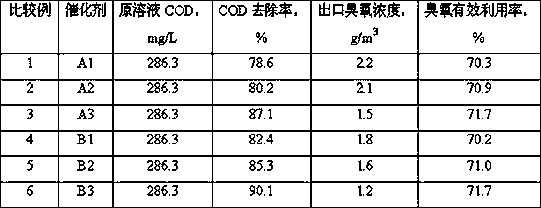Method for treating wastewater through catalytic wet oxidation of ozone
A technology of wet oxidation and ozone catalysis, which is applied in the fields of oxidizing water/sewage treatment, chemical instruments and methods, chemical elements of heterogeneous catalysts, etc. , The effect of the method and process is simple
- Summary
- Abstract
- Description
- Claims
- Application Information
AI Technical Summary
Problems solved by technology
Method used
Image
Examples
preparation example Construction
[0020] Preparation of Catalyst A1 (Fe / Al 2 o 3 )
[0021] The macroporous alumina powder and peptizer are kneaded, rolled, and extruded to make a clover-shaped carrier with a diameter of 2.5 mm, and then calcined at 550 ° C in the air to obtain Al 2 o 3 Carrier, specific surface area 220 m 2 / g, pore volume 0.7 cm 3 / g, the average pore diameter is 10.4nm. Weigh 500g of alumina carrier, according to its water absorption with Fe(NO 3 ) 3 9H 2 O by Fe 2 o 3 Accounting for the ratio of 7.5% of the total weight of the catalyst to form a solution. An equal volume of the solution was used to impregnate the alumina carrier for 2 hours, dried at 80° C., and then calcined in a muffle furnace at 550° C. for 4 hours. After the temperature dropped to room temperature, it was taken out to obtain catalyst A1.
[0022] Preparation of Catalyst A2 (Cu-Ce / SiO 2 )
[0023] The diameter is 2.0mm, the specific surface area is 207m 2 / g, pore volume 0.8 cm 3 / g, strip-shaped SiO with...
Embodiment 1
[0033] The catalysts A1 and B1 are loaded into the cylindrical reactor according to the volume percentage of 50% and 50% respectively, and the total volume of the catalyst is 100cm 3 . Acid scarlet simulated dye wastewater (COD: 286.3 mg / L) enters the reactor from the bottom of the reactor at a rate of 200 mL / h, the residence time in the catalyst bed is 30 minutes, and the ozone concentration is 9.5 g / m 3 , at a rate of 400 mL / min, enters the bottom of the reactor together with the waste water. The reaction is carried out at normal temperature and pressure. After the reaction, the COD of the liquid is tested, and the catalyst activity is measured according to the removal rate of COD. The ozone concentration before and after the reactor is detected online with an ozone detector to calculate the effective utilization rate of ozone. The results are listed in Table 1.
Embodiment 2
[0035] Catalysts A2 and B1 were loaded into the reactor according to volume percentages of 40% and 60% respectively, and the reaction conditions were the same as in Example 1. The results are listed in Table 1.
PUM
| Property | Measurement | Unit |
|---|---|---|
| pore size | aaaaa | aaaaa |
| chemical oxygen demand (mass) | aaaaa | aaaaa |
| diameter | aaaaa | aaaaa |
Abstract
Description
Claims
Application Information
 Login to View More
Login to View More - R&D
- Intellectual Property
- Life Sciences
- Materials
- Tech Scout
- Unparalleled Data Quality
- Higher Quality Content
- 60% Fewer Hallucinations
Browse by: Latest US Patents, China's latest patents, Technical Efficacy Thesaurus, Application Domain, Technology Topic, Popular Technical Reports.
© 2025 PatSnap. All rights reserved.Legal|Privacy policy|Modern Slavery Act Transparency Statement|Sitemap|About US| Contact US: help@patsnap.com



